Exploring sacred beauty: Churches in the Old City of Dubrovnik
Nestled on the stunning Adriatic coastline, the historic city of Dubrovnik is a gem that has captivated travellers for centuries. Beyond its imposing architecture, breathtaking views, and rich history, churches are a must-explore site that reflects its deep religious and cultural heritage. With a predominantly Roman Catholic population, religious traditions play a vital role in shaping community bonds and cultural celebrations. The annual festivities and processions not only showcase the city’s faith but also offer visitors a glimpse into the profound connection between spirituality, history, and daily life in Dubrovnik.
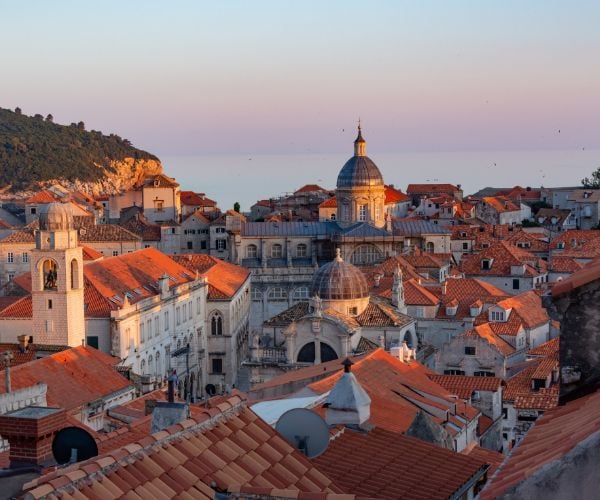
While Roman Catholicism is the predominant religion in Dubrovnik, the city also embraces religious diversity. Over the years, various religious communities have found their place within its walls, adding to the cultural richness. Orthodox Christianity has a presence, particularly among the Serbian population, with the Serbian Orthodox Church maintaining a strong connection. Additionally, there are smaller communities practising Islam, Judaism, and other faiths. This religious diversity contributes to the city’s vibrant tapestry and promotes an environment of tolerance and understanding.
Let’s explore deeper into the captivating facets that make the Old City’s architecture an unparalleled gem within Dubrovnik’s architectural crown.
Dubrovnik Cathedral (Assumption of the Virgin Mary)
Dominating the city’s skyline, the Dubrovnik Cathedral stands as a testament to the city’s enduring faith. Dedicated to the Assumption of the Virgin Mary, this impressive Baroque cathedral features a stunning facade adorned with sculptures and a grand bell tower. Step inside to marvel at its impressive interior, where masterpieces like Titian’s “Assumption of the Virgin Mary” and a revered relic – the head of St. Blaise, the city’s patron saint – are kept.
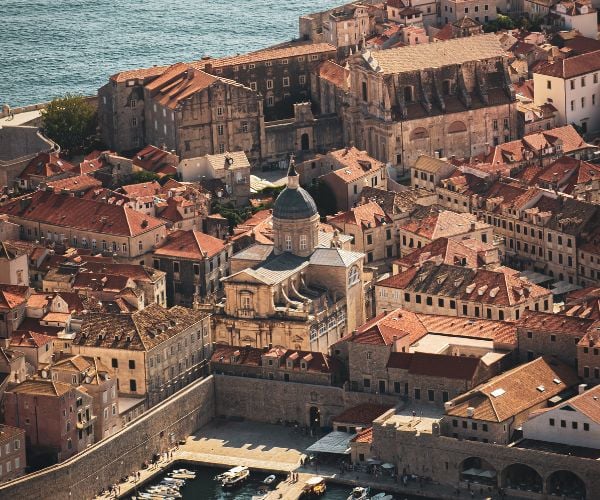
Beyond its architectural and artistic significance, the Dubrovnik Cathedral remains a living centre of worship and spirituality. Regular masses and religious ceremonies are conducted here, allowing locals and visitors to partake in the city’s ongoing traditions. The Cathedral’s significance isn’t limited to its appealing beauty; it’s a place where people gather to celebrate their beliefs, share in communal worship, and find consolation.
St. Blaise Church
The Church of St. Blaise, dedicated to Dubrovnik’s beloved patron saint, offers a captivating glimpse into the past. Its origins trace back to the 14th century when Dubrovnik’s residents began construction to honour St. Blaise’s protection during times of adversity.
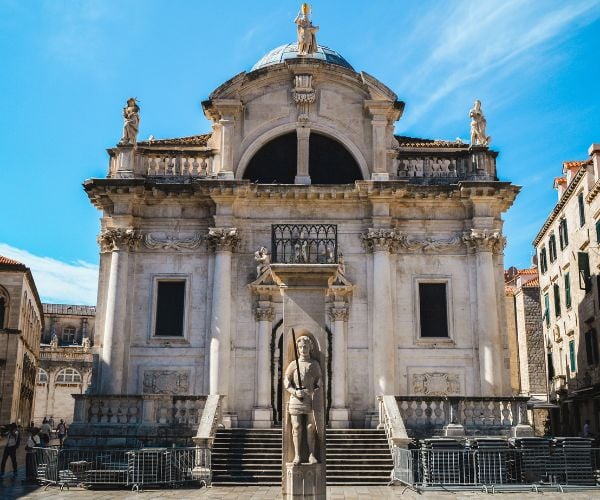
Approaching the church, located on Luža Square, your gaze is drawn to the stunning facade that pays homage to St. Blaise’s legacy. A harmonious blend of Gothic and Baroque styles, statues of saints and angels adorning its facade, intricate reliefs, and detailed carvings adorn the exterior, telling stories of the saint’s life and the city’s devotion. The statue of St. Blaise atop the facade stands as a guard, watching over Dubrovnik’s streets with a reassuring presence.
The interior is equally breathtaking, with intricate altars and a serene ambience that invites visitors to reflect and connect with the city’s history.
Upon entering the church, the interior captivates with its elegant simplicity. The Baroque influences are evident in the decorative altars, ornate chandeliers, and delicate frescoes that adorn the walls and ceilings. The aura of serenity envelops you, inviting contemplation and a pause from the bustling world outside. It’s a place where milestones are celebrated, where generations come together for baptisms and weddings. It’s a space where tourists and locals alike can find solace, inspiration, and a sense of belonging.
Franciscan Church and Monastery
A tranquil oasis amidst the bustling Old City, the Franciscan Church and Monastery offers a serene escape for both locals and tourists. The peaceful cloister, enveloped by the greenery of a tranquil garden, invites visitors to step away from the mundane world and find a moment of introspection. The gentle rustle of leaves and the soothing echoes of footsteps on stone create a serene symphony, allowing one to connect with their thoughts and the beauty of the surroundings.
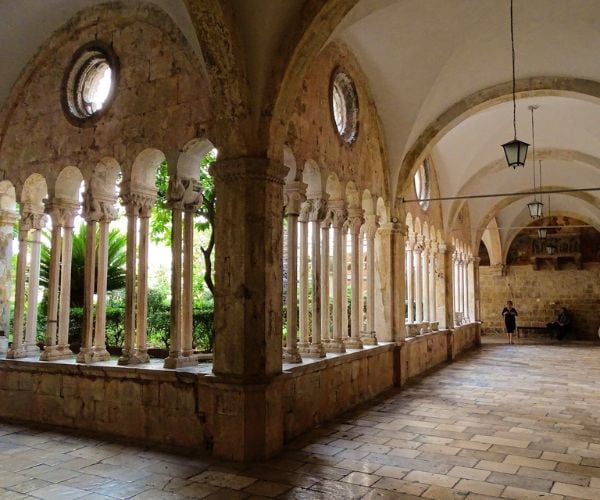
Known for its impressive Romanesque-Gothic architecture, the complex boasts a captivating cloister with an enchanting garden. Beyond its picturesque facade, you’ll find a treasury filled with religious artefacts, including ancient manuscripts and a revered pharmacy that has been operating for centuries. this architectural masterpiece holds a treasure trove of artefacts, a storied past, and a pharmacy that has defied the march of time.
IMPORTANT NOTICE:
If you are reading this article anywhere other than on A Luxury Travel Blog, then the chances are that this content has been stolen without permission.
Please make a note of the web address above and contact A Luxury Travel Blog to advise them of this issue.
Thank you for your help in combatting content theft.
One of the Franciscan Monastery’s most captivating features is its pharmacy, which is considered one of the oldest in Europe. The pharmacy’s wooden shelves are lined with ancient jars and vials, standing as a living testament to centuries of healing knowledge. The fragrant scents of dried herbs and remedies evoke a sense of stepping back in time, inviting visitors to imagine the monks tending to the health of both body and spirit. Through its botanical beauty, architectural splendour, and enduring traditions, the Franciscan Church and Monastery invite you to become a part of Dubrovnik’s ongoing story.
Church of St. Ignatius
The Church of St. Ignatius stands as a masterpiece of Baroque architecture. One of the Church of St. Ignatius’s most distinctive features is the grand staircase leading up to the entrance. Known as the “St. Ignatius’ Steps,” this impressive set of stairs is a popular attraction in Dubrovnik. The staircase was featured in scenes from the television series “Game of Thrones,” further increasing its popularity among tourists.
Inside the church, visitors can find various paintings and frescoes that narrate the life and deeds of Saint Ignatius and other significant religious figures. These artworks offer insight into the religious and cultural values of the time and provide a visual representation of the stories they portray. Over the years, the Church of St. Ignatius has undergone restoration efforts to preserve its architectural and artistic elements. These efforts ensure that the church remains accessible for generations to come, allowing people to continue appreciating its beauty and historical value.
Dominican Monastery
The construction of the Dominican Monastery dates back to the 13th century, making it one of the oldest preserved structures in Dubrovnik. Immerse yourself in history and explore a glimpse into Dubrovnik’s medieval past.
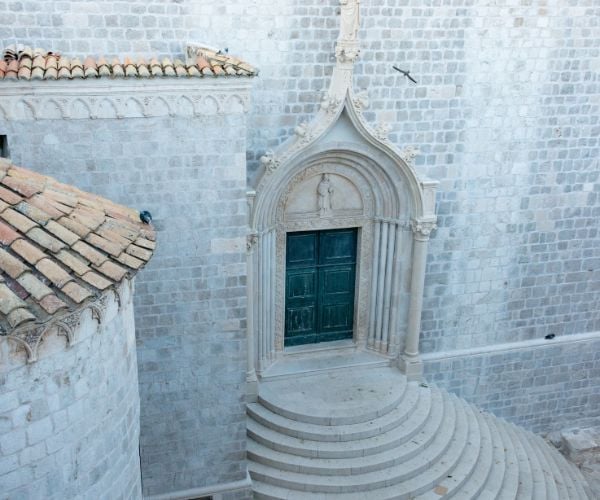
The monastery’s elegant Gothic architecture is a sight to behold, and its museum houses an impressive collection of religious art and artefacts. The highlight is undoubtedly the serene cloister, an oasis of tranquillity that invites contemplation.
The architecture of the Dominican Monastery is a blend of various styles that reflect the monastery’s long history and the artistic influences of different eras. The exterior façade showcases elements of Gothic and Renaissance styles, while the interior features intricate details, arches, and columns. The cloister, with its peaceful courtyard and elegant architecture, offers a serene escape from the bustling city outside. The Dominican Monastery is renowned for its collection of artwork and artefacts that provide insights into the cultural and artistic history of Dubrovnik. The monastery’s treasury houses various religious items, including illuminated manuscripts, gold and silver religious objects, and ornate vestments. The monastery’s rich collection reflects the devotion and artistic talent of its inhabitants over the centuries.
One of the highlights of the Dominican Monastery is its library, which contains a valuable collection of books and manuscripts. The library holds works of theology, philosophy, literature, and science, showcasing the intellectual pursuits of the Dominican monks throughout history. The library’s architecture and ambience add to the sense of reverence and knowledge that pervades the space.
Orthodox Church
The Orthodox Church, although representing a smaller religious community, is a significant thread in the rich city’s history. The presence of the Orthodox Church in Dubrovnik dates back centuries and is closely intertwined with the city’s historical connections to the Byzantine Empire and its position as a hub for trade and cultural exchange. Despite the surrounding Catholic majority, the Orthodox community has preserved its distinct identity, maintaining its religious practices and traditions.
The Orthodox Church stands as an architectural gem that echoes the aesthetics of Byzantine and Eastern Orthodox traditions. With its intricate icons, detailed frescoes, and ornate decorations, the church offers a visual representation of the Orthodox faith’s artistic and spiritual depth. Amidst the historic city walls, this church reminds us that faith, culture, and heritage can coexist harmoniously, contributing to the city’s allure as a place of history, spirituality, and unity.
Hidden sacral treasures
In Dubrovnik, there are churches that hold a unique and fascinating tradition of conducting Holy Mass only once a year. These churches are often located in remote or less accessible areas, and the annual Mass serves as a significant event that brings communities together and provides a strong connection to religious and cultural heritage. Among them, the Church of St. Vid stands out, as it is a small church that is privately owned. Discover the greatness of the Church of Our Lady of Karmen, the largest of its kind, proudly adorned with the iconic Dubrovnik emblem. As you explore, don’t miss the chance to uncover the captivating stories held within the Church of St. Anne and St. Blaise in Gorica. These ancient sanctuaries whisper tales of faith and devotion. And, of course, your journey wouldn’t be complete without a visit to the enchanting church on Danče, a place where history and holiness intertwine. In recent years, these annual Masses have also gained attention from tourists interested in experiencing unique cultural and religious events. This interest from visitors can bring a new dimension to these traditions, fostering cultural exchange and appreciation.
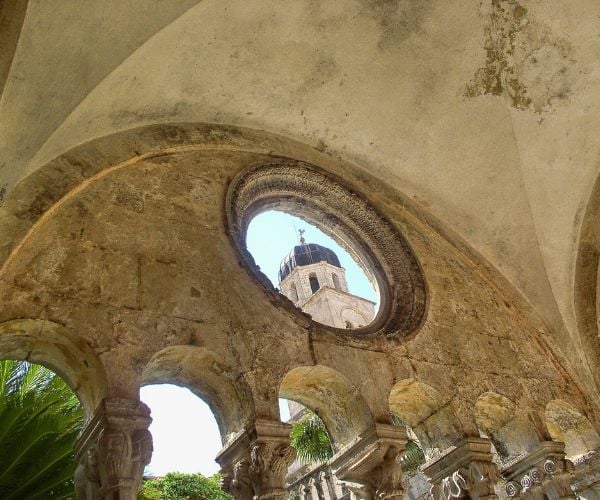
Dubrovnik’s churches are not only architectural wonders but also repositories of the city’s spiritual and cultural heritage. Each church tells a unique story and contributes to the tapestry of this remarkable city. Whether you’re an art or history enthusiast, or simply seeking a moment of quiet reflection, a tour of these churches in Old City Dubrovnik promises an unforgettable journey.
Christian Larss Kreković is a General Manager at Sun Gardens Dubrovnik. Sun Gardens Dubrovnik is a luxury resort on the Adriatic coast in Croatia offering bespoke guest experiences.
If you would like to be a guest blogger on A Luxury Travel Blog in order to raise your profile, please contact us.
Did you enjoy this article?
Receive similar content direct to your inbox.


On a busy holiday it’s always nice to take a quiet moment out and to visit a church or two. As well as taking in the architecture it’s nice to say a prayer.
My old history teacher always used to say that if you want to get to the roots of a city’s history make sure that you dip into its places of worship.
Taking a look at these buildings you soon get the impression that Dubrovnik’s spiritual life has seen plenty of drama.
That’s the great thing about travel, you can almost step back in time. What we often forget is that in the centuries before power tools these churches would have taken decades, sometimes centuries to build. Sometimes, when plans were drawn up, the men involved knew that the church would not be completed in their day, they had the vision and faith to build for future generations.
Wow! There’s quite a variety of architectural styles covered by these spiritual homes. We’re lucky that they’ve survived, been preserved and are still with us today.
Having read a few of these posts about Dubrovnik on A Luxury Travel Blog I’m beginning to appreciate that there’s a lot more to Dubrovnik than I ever imagined. The city has got hidden depths.
You mentioned annual masses in small churches. Are these days advertised anywhere? I can’t seem to find them mentioned anywhere else, but they would be very cool to go to. Thanks!